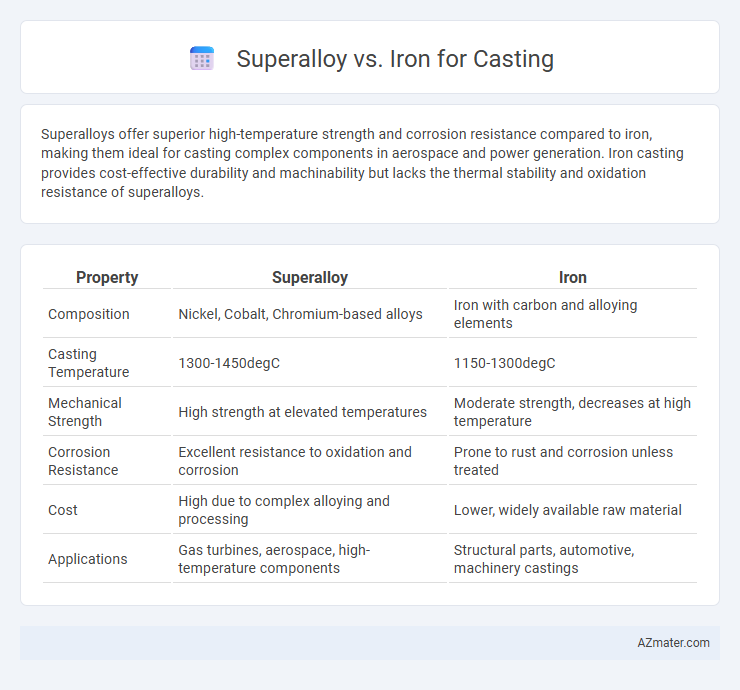Superalloys offer superior high-temperature strength and corrosion resistance compared to iron, making them ideal for casting complex components in aerospace and power generation. Iron casting provides cost-effective durability and machinability but lacks the thermal stability and oxidation resistance of superalloys.
Table of Comparison
| Property | Superalloy | Iron |
|---|---|---|
| Composition | Nickel, Cobalt, Chromium-based alloys | Iron with carbon and alloying elements |
| Casting Temperature | 1300-1450degC | 1150-1300degC |
| Mechanical Strength | High strength at elevated temperatures | Moderate strength, decreases at high temperature |
| Corrosion Resistance | Excellent resistance to oxidation and corrosion | Prone to rust and corrosion unless treated |
| Cost | High due to complex alloying and processing | Lower, widely available raw material |
| Applications | Gas turbines, aerospace, high-temperature components | Structural parts, automotive, machinery castings |
Introduction to Casting Materials
Superalloys and iron represent two critical categories of casting materials, each with distinct properties suited for specific applications. Superalloys, primarily composed of nickel, cobalt, or iron-based matrices, offer exceptional high-temperature strength, corrosion resistance, and mechanical stability, making them ideal for aerospace and turbine components. Iron casting materials, including gray iron, ductile iron, and white iron, provide good wear resistance, castability, and cost-efficiency, widely utilized in automotive, machinery, and infrastructure parts.
Understanding Superalloys
Superalloys, primarily composed of nickel, cobalt, or iron, excel in casting applications requiring exceptional heat resistance and mechanical strength, outperforming traditional iron alloys. Their intricate microstructures, enhanced by elements like chromium, molybdenum, and aluminum, provide superior oxidation and corrosion resistance in high-temperature environments. Understanding the precise alloy composition and casting techniques is crucial for optimizing the performance and durability of superalloy components in aerospace, power generation, and industrial applications.
Properties of Iron in Casting
Iron used in casting exhibits excellent thermal conductivity and high wear resistance, making it suitable for components subjected to high stress and temperature fluctuations. Its good fluidity and low melting point ensure precise mold filling and intricate detail replication in complex castings. Cast iron alloys often possess superior compressive strength and vibration damping capabilities compared to most superalloys, enhancing durability in heavy-duty applications.
Mechanical Strength Comparison
Superalloys exhibit superior mechanical strength compared to iron in casting applications, maintaining high tensile strength and creep resistance at elevated temperatures beyond 1000degC. Iron castings, while cost-effective and offering good wear resistance, generally show lower yield strength and reduced performance under thermal and mechanical stress. The enhanced alloying elements in superalloys provide improved fatigue resistance and dimensional stability critical for high-performance components in aerospace and power generation industries.
Heat Resistance: Superalloy vs Iron
Superalloys exhibit superior heat resistance compared to iron, maintaining mechanical strength and oxidation resistance at temperatures exceeding 1000degC, whereas iron alloys typically lose strength and suffer scaling above 600degC. The advanced composition of superalloys, including elements like nickel, chromium, and cobalt, enhances their thermal stability and corrosion resistance in high-temperature environments. Iron castings are more prone to deformation and oxidation under intense heat, limiting their use in aerospace and high-performance applications where superalloys are preferred.
Corrosion Resistance: Key Differences
Superalloys exhibit significantly higher corrosion resistance compared to iron due to their complex alloying elements such as nickel, chromium, and molybdenum, which form stable oxide layers protecting the material from aggressive environments. Iron castings, primarily composed of iron and carbon, are more prone to oxidation and rust, especially in moisture-rich or acidic conditions, leading to faster degradation. The enhanced corrosion resistance of superalloys makes them ideal for high-temperature, chemically aggressive applications where iron would fail prematurely.
Casting Process Considerations
Superalloys require precise temperature control and slower cooling rates during the casting process to maintain their high-temperature strength and corrosion resistance, unlike iron, which tolerates a broader range of cooling speeds. The casting molds for superalloys must be designed to accommodate thermal expansion and solidification shrinkage, reducing defects such as hot tearing. Iron casting is generally more forgiving, allowing faster production cycles, but lacks the high-performance characteristics achievable with superalloys.
Cost Analysis: Superalloy vs Iron
Superalloys exhibit significantly higher raw material and processing costs compared to iron due to their complex compositions and specialized casting techniques. Iron casting benefits from lower material expenses and widespread manufacturing infrastructure, resulting in a cost-effective solution for many industrial applications. The choice between superalloy and iron hinges on weighing the premium cost of superalloys against their superior high-temperature strength and corrosion resistance.
Applications in Industry
Superalloys offer superior high-temperature strength, corrosion resistance, and creep resistance, making them ideal for aerospace turbine blades, gas turbines, and nuclear reactors. Iron, particularly cast iron and ductile iron, remains widely used in automotive engine blocks, pipes, and heavy machinery due to its excellent castability and cost-effectiveness. Industries prioritize superalloys in critical, high-stress environments while relying on iron for structural components requiring durability at a lower cost.
Choosing the Right Alloy for Casting
Selecting the right alloy for casting depends on the application's performance requirements, with superalloys offering superior high-temperature strength, corrosion resistance, and fatigue resistance compared to iron. Iron castings, including gray and ductile cast iron, provide excellent machinability, cost-effectiveness, and wear resistance for moderate temperature environments. Engineers prioritize superalloys for aerospace and power generation components, while iron alloys remain prevalent in automotive and construction sectors due to their balance of strength and affordability.

Infographic: Superalloy vs Iron for Casting
 azmater.com
azmater.com